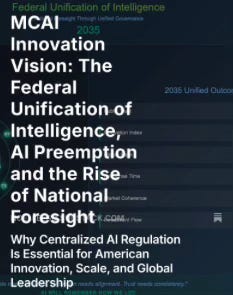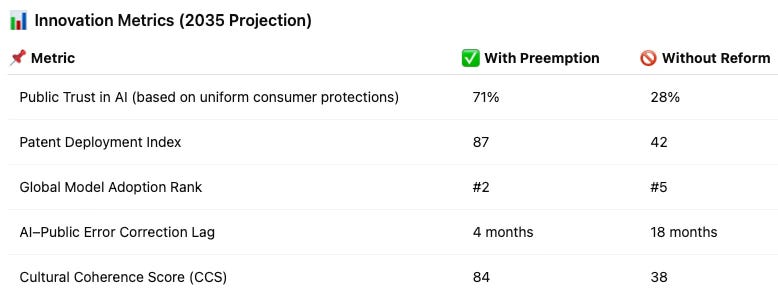MCAI Innovation Vision: The Federal Unification of Intelligence, AI Preemption and the Rise of National Foresight
Why Centralized AI Regulation Is Essential for American Innovation, Scale, and Global Leadership
🧭 I. Introduction: A Nation at the Technological Frontier
In May 2025, while America debated infrastructure spending, Congress took a decisive step toward future readiness—consolidating AI regulation under one national framework. Through the "One Big Beautiful Bill Act," a ten-year federal preemption clause prohibited states from independently regulating artificial intelligence systems. From autonomous vehicles to education platforms to medical diagnostics, the U.S. now speaks with one voice on how intelligence is governed.
National oversight doesn’t abandon democratic foresight—it modernizes it. Just as federal aviation and securities laws fostered growth through unified trust and safety standards, AI demands coherence across markets and industries. By 2030, when your daughter applies to college, she will face an AI admissions system tested for fairness at the national level—not twisted by fifty competing rulebooks.
🔍 Insight: The AI preemption clause eliminates confusion and builds a reliable foundation for innovation, trust, and strategic alignment.
⚖️ II. The Clause: Constitutional Strength, Strategic Clarity
Grounded in the Constitutional Commerce Clause, the law treats AI systems as what they are—nationwide networks. Regulating them like interstate commerce ensures both legal sense and operational efficiency. Congress paired this logic with the Necessary and Proper Clause to build predictable rules for a rapidly evolving domain.
AI no longer functions as a local experiment—it shapes national infrastructure. Fragmented oversight invites legal clashes, multiplies compliance costs, and delays responsible deployment. Business leaders and policymakers gain agility when one rulebook replaces fifty.
🔍 Insight: The law draws on constitutional precedent to streamline oversight where national consistency drives global advantage.
🌱 III. What’s Gained: Innovation Through Scale, Not Fragmentation
State initiatives like California’s algorithmic audits or Illinois’s biometric privacy rulings sparked valuable insights. But scattered laws created costly inconsistencies. Facebook paid $650 million under one state's standard—while operating across fifty.
Preemption elevates those lessons. Federal regulators absorb and apply best practices at scale. Startups can launch without deciphering a maze of local laws. Engineers focus on performance, not paperwork.
🔍 Insight: Preemption fuels velocity by transforming scattered compliance barriers into catalysts for focused innovation.
💥 IV. Strategic Consequences: Resilience Through Unified Governance
Uniformity doesn’t mean rigidity—it closes loopholes, accelerates correction, and aligns outcomes. Oversight offices shrink not because they vanish, but because integrated systems eliminate redundant bureaucracy.
Centralized governance builds resilience. Companies operate across state lines with confidence. Consumers rely on consistent protections. Strategic foresight intensifies, channeling attention into outcomes rather than negotiation.
🔍 Insight: Unified oversight converts friction into flexibility, enabling systems to adapt rapidly without sacrificing integrity.
📉 V. Ten-Year Innovation Forecast: 2025–2035
🛫 Years 1–2: Foundation and Momentum
Federal standards replace fragmented rules.
Investment spikes. AI IPOs multiply.
Ethics evolves into data-centric, scalable governance.
🔍 Insight: Legal certainty sparks early-stage momentum and unlocks capital.
🧱 Years 3–5: Scale and Global Alignment
Talent flocks to U.S. firms drawn by stable rules.
American standards inform global agreements.
🔍 Insight: Unified policy positions America to shape the global ethics architecture.
⚠️ Years 6–8: Optimization and Oversight Cycles
Agencies revise standards based on real-world failures.
AI safety adjusts dynamically across use cases.
🔍 Insight: Federal learning systems accelerate corrections that would stall in a fragmented regime.
🔮 Years 9–10: AI as Civic Infrastructure
National AI systems achieve infrastructure status, like roads or power grids.
Policy integrates public feedback without jurisdictional gridlock.
🔍 Insight: National coherence transforms AI from private utility to public trust.
🌐 VI. Foresight Secured: A National Innovation Constitution
Preemption doesn’t silence democratic feedback—it amplifies it through a learning network. Picture regulators, engineers, researchers, and communities co-authoring national policy. Every failure informs a smarter baseline. Every breakthrough propagates instantly.
This is systems thinking in action. The framework mirrors federated learning applied to governance: train everywhere, regulate once.
🔍 Insight: Unified frameworks transform foresight into a shared, adaptive civic function.
📣 VII. Conclusion: AI Will Remember How We Led
National coherence isn’t bureaucracy—it’s readiness. The preemption clause marks a new chapter in U.S. leadership: structured scale, consistent standards, and high-trust innovation.
Leaders shaping the next decade must recognize the formula: scale follows structure, innovation follows alignment, and trust follows coherence.
Act now. Back this vision. Build institutions that listen, evolve, and guide. AI will remember how we governed—and so will history.
Prepared by Noel Le, Architect of MindCast AI LLC. Noel holds a background in law and economics. noel@mindcast-ai.com, www.linkedin.com/in/noelleesq/




